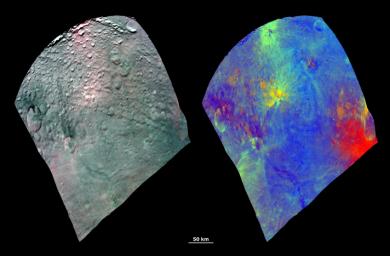
|
Color Composite Images of Vesta
- Click the image above for a larger view
- Full-Res JPEG (3000 x 1968) (517.0 kB)
- Full-Res TIFF (3000 x 1968) (17.7 MB)
Caption:
These Dawn FC (framing camera) composite images show the spectacular spectral diversity of Vesta's surface. The FC has 7 color filters which allow it to image Vesta in a number of different wavelengths of light. Being able to image in many wavelengths enhances features and colors that would otherwise be indistinguishable to the human eye. The left image shows a RGB color composite image of Vesta. RGB stands for red, green and blue and in this case red is the 750nm filter, green is the 920nm filter and blue is the 980nm filter. Nm stands for nanometers and is a measure of the wavelength of light. The images from these 3 filters were combined into this one RGB composite image, which enhances Vesta's coloration. The right image is also a RGB composite image. This time red is the ratio of the brightness at a wavelength of 750nm to the brightness at 440nm; green is used for the ratio of the brightness at 750nm to 920nm and blue is used for the ratio of the brightness at 440nm to 750nm. These ratios have all been picked for specific scientific purposes. The green shows the relative strengh of a particular mineralogical characteristic, the ferrous absorption band, at 1000nm so that a brighter green color signifies a higher relative strength of this band. The blending between the red and blue heightens the color range of visible light.
NASA's Dawn spacecraft obtained these images with its framing camera on August 11th 2011. These images were assembled from images taken through the camera's color filters. The distance to the surface of Vesta is 2740km and the images have a resolution of about 250 meters per pixel.
Background Info:
The Dawn mission to Vesta and Ceres is managed by NASA's Jet Propulsion Laboratory, a division of the California Institute of Technology in Pasadena, for NASA's Science Mission Directorate, Washington D.C. UCLA is responsible for overall Dawn mission science. The Dawn framing cameras have been developed and built under the leadership of the Max Planck Institute for Solar System Research, Katlenburg-Lindau, Germany, with significant contributions by DLR German Aerospace Center, Institute of Planetary Research, Berlin, and in coordination with the Institute of Computer and Communication Network Engineering, Braunschweig. The Framing Camera project is funded by the Max Planck Society, DLR, and NASA/JPL.
More information about Dawn is online at http://www.nasa.gov/dawn and http://dawn.jpl.nasa.gov .
Cataloging Keywords:
| Name | Value | Additional Values |
|---|---|---|
| Target | 4 Vesta | |
| System | Main Belt | |
| Target Type | Asteroid | |
| Mission | Dawn | |
| Instrument Host | Dawn | |
| Host Type | Orbiter | |
| Instrument | Framing Camera (FC) | |
| Detector | ||
| Extra Keywords | Color | |
| Acquisition Date | ||
| Release Date | 2011-10-25 | |
| Date in Caption | ||
| Image Credit | NASA/JPL-Caltech/UCLA/MPS/DLR/IDA | |
| Source | photojournal.jpl.nasa.gov/catalog/PIA14964 | |
| Identifier | PIA14964 | |
